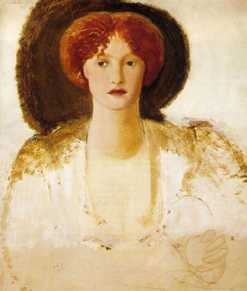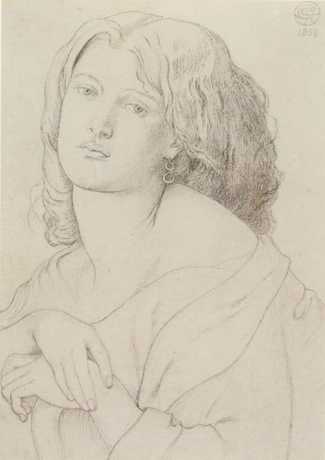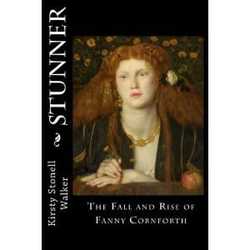 Stephanie Graham Piña is an independent scholar whose research focuses on Victorian Art, especially the Pre-Raphaelites. In 2004 she created LizzieSiddal.com, a resource for those interested in the life of Pre-Raphaelite model and painter Elizabeth Siddal. She established her website 'The Pre-Raphaelite Sisterhood' in 2007 to highlight the work of women artists associated with the Pre-Raphaelite Circle. Through her popular online publications, she has been a leading advocate of independent research and discourse on Victorian art. You can follow her at @beguilingmerlin. Here, Stephanie discusses how Fanny Cornforth, one of the most influencial models and muses to the Pre-Raphaelite artists, has been remembered by historians and critics. Unlike other Pre-Raphaelite models, such as Lizzie Siddal or Jane Morris, Fanny was a sex worker and from an impoverished background. She is described as having a thick Cockney accent, a dirty sense of humor, and dubious morals. Whilst it is perhaps understandable that Victorian moralists would dismiss Fanny's artistic influence, Stephanie suggests this prejudice continues today. You can help fund a tribute to Fanny. We hope to commission a memorial to be installed with a commemoration ceremony in Chichester Cemetery on April 9, 2017. Any additional funds raised will be used to commission a memorial to her at Graylingwell Chapel. Please visit the GoFundMe account for this project and share it as much as you can. Spread the word on social media using the hashtag #RememberFanny. GoFundMe: Fanny Cornforth Remembered created by Sarah Rance-Riley  Sir Edward Burne-Jones used Fanny Cornforth as a model for his unfinished painting, Hope, left. Although incomplete, it remains one of my favorite paintings of Fanny. As Jan Marsh points out in Pre-Raphaelite Women: Images of Femininity in Pre-Raphaelite Art, in Hope it is possible to ‘appreciate the ‘fine regular features’ that attracted so many admirers before her elephantine days’. Taken out of context, the word elephantine may seem harsh, until you know that elephant and rhinoceros were Fanny and Dante Gabriel Rossetti’s nicknames for each other. Actually, no, it still seems harsh. Rossetti meant it affectionately, but perhaps a pet name derived by Fanny’s stout figure is also part of the reason it is so easy to be dismissive of her. We can view her as a comical elephant as opposed to the angelic being a Victorian woman was supposed to aspire to be. Fanny isn’t taken as seriously as the other muses in Rossetti’s life. Her past as a prostitute and her years spent as Rossetti’s housekeeper makes her place in his life difficult to write about in any other way than sexually. But there is no denying that it is her face that appears in the first work that ushered in a radical new style for him, a style that set the tone for type of work that is now synonymous with the name Rossetti.  I recently read a random comment on a blog, a comment that I won’t quote here but in essence it said that the poster had no desire to read or learn about Fanny Cornforth because of her character. Are we really still that judgmental? Granted, one lone comment online does not reflect the opinion of everyone, but Fanny is so often described as a prostitute while Jane Morris and Elizabeth Siddal are almost always descibed as muses. Certainly, Rossetti felt affection for all of them. With them, for them, and because of them he created many beautiful works. Perhaps one reason Elizabeth Siddal and Jane Morris are viewed as respectable while Fanny is not is that they made efforts to not only improve their station in life, but to join the Pre-Raphaelites in their artistic pursuits. Siddal studied art seriously and created drawings, paintings, and poems that showed great promise. Morris educated herself, shedding her lower-class background and becoming a talented embroiderer in her husband’s firm. On the opposite end of the spectrum is Fanny Cornforth, repeatedly described with a thick Cockney accent, ribald humor, and dubious morals. She did not endeavor to become an artist or to better herself. Due to the Victorian class system, we can understand why early biographers felt they had to describe Cornforth in such a dismissive way. But should we indulge in such bias today? When discussing the lives of historical figures, especially in the case of Dante Gabriel Rossetti, it is easy to be judgmental. A lot of his choices are questionable at best and his treatment towards the women in his life leaves a lot to be desired. But he was also quite generous with his support and championed women artists wholeheartedly. It is no understatement to say that he and Fanny were both flawed. However, the vitriol I often see directed towards them in online comments is rampant. Much of it is based on unsubstantiated innuendo, such as the belief that he was with Fanny or Jane the night his wife died when we know he was at Working Men’s College. Before I go any further, I should say that I am firmly in Elizabeth Siddal’s corner, I’ve spent eleven years compiling information about her life online at LizzieSiddal.com. However, I just can not justify pitting Lizzie, Jane, and Fanny against each other. I prefer to take a somewhat unbiased approach. Whether they live today or a hundred years ago, people are complex and nuanced. We cannot treat them as one-dimensional caricatures. Fanny may not have tried to elevate herself to a higher class, but we should not hold that against her. What we should remember is that she was one of Rossetti’s truest friends. She cared for him long after she had been replaced as his muse. Yes, she was labeled a thief and a whore by many in Rossetti’s circle. Instead of perpetuating that label, we should attempt to delve deeply into her life to see if such a label is truly deserved.  I recommend Stunner: The Fall and Rise of Fanny Cornforth. Written by Kirsty Stonell Walker, it is the first full length biography of Fanny Cornforth and it provides a straightforward, unflinching account of Fanny, her relationship with Dante Gabriel Rossetti, and her struggles in a society that attempted to tame her. You may remember from previous posts that it was Kirsty Stonell Walker her solved the mystery of Fanny’s final years as well as the location of her grave. Fanny helped Rossetti create and her presence in his life helped launch a new direction to his work. She was ridiculed for her faults of speech, her size, and her background. I propose that we at least try to treat her with the same respect afforded to Jane Morris, Elizabeth Siddal, and other women in the Pre-Raphaelite Circle. Let’s resist the urge to perpetuate Victorian ideals and dismiss Fanny because she was not a wife or a proper lady. I am not saying we should idealize her or gloss over any aspect of her life. But let’s at least have a little compassion and understanding for the circumstances in which she lived. It was an era that was not kind to women, especially women of a certain class. She remained staunchly loyal to Rossetti until the bitter end. And without her in his life, we would be deprived of this magnificent work: ......................................................................................................................................................... We now know that Fanny died in Graylingwell on February 24, 1909 and was buried in an unmarked paupers grave in Chichester Cemetery. Her face graces masterpieces that visitors from all over the world seek out in museums. Through the works of Rossetti, her beauty has been admired by millions. She deserves to be commemorated. You can help fund a tribute to Fanny. We hope to commission a memorial to be installed with a commemoration ceremony in Chichester Cemetery on April 9, 2017. Any additional funds raised will be used to commission a memorial to her at Graylingwell Chapel. Please visit the GoFundMe account for this project and share it as much as you can. Spread the word on social media using the hashtag #RememberFanny. GoFundMe: Fanny Cornforth Remembered created by Sarah Rance-Riley
0 Comments
Leave a Reply. |
Sex History ContentsIf you would like to submit an article, please fill out a submission on the Contact page Archives
September 2020
|
 RSS Feed
RSS Feed